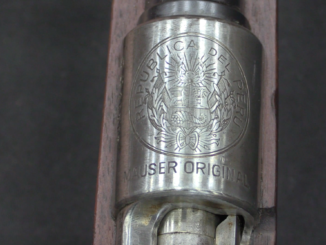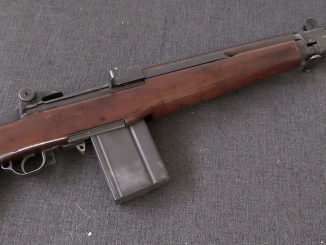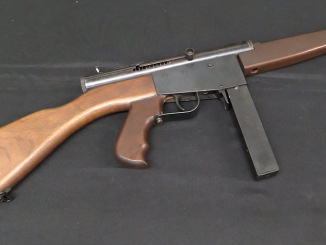This carbine is coming up for sale here.
Peru acquired a large stock of Model 1891 Mausers from Argentina in 1901, and the carbine we are looking at today is a conversion form one of those long rifles – not a factory carbine. A few hundred of these conversions were done in the 1930s for the Peruvian Navy, and the result is a pretty interesting configuration, I think. The guns have 1909-type langevisier “roller-coaster” rear sights, which don’t appear to have been calibrated with the barleycorn front sights of the marked range settings (400-2000m). The hand guard is retained form the 1891 long rifle, and the barrels include a variety of replacement types – this one is Belgian proofed, making it almost certainly an FN barrel purchased in the 1930s as well. The other interesting mark is a date stamp of 1963 on the stock. This seems very unlikely to have been the date of conversion (which is almost certainly in the 30s), and these dates vary between 1963 and 1968 on other observed carbines like this. Whether is was added by an importer for some reason or perhaps as a property mark in the 60s by the Peruvian Navy (or some other reason altogether) remains a mystery.




Oh goodness! What a hodgepodge of mashed up features. I don’t want eat lead coming out of them, however…
With all that stuff on it, I don’t think you would have to worry. Sounds like the sites were set for a different round starting at 400 yd range. Then, they changed the round and shortened the barrel.
Who knows where that slug will end up!
Now I know finally what is my Peruvian Carbine 🙂 Thank you so much for the video. http://www.andreaturchi.org/Moschetto_Modello_1891_.html Sorry my website is in italian and to see the pictures you must click the numbers of the page. best regards
“1909-type langevisier “roller-coaster” rear sights, which don’t appear to have been calibrated with the barleycorn front sights of the marked range settings (400-2000m).”
Regarding this I have question: which system (metric or imperial?) used Peru in 1930s and which one Argentine? Also more generally which systems were used in South America countries back then?
Metric.
Latin American militaries “professionalized” in the late 19th century and invited in all sorts of vogue-ish au courant du jour European military advisers. Brazil, Mexico, and Peru went for France. Chile and Argentina went for Prussian/Germans. Colombia couldn’t really afford much, so they went for Chileans as ersatz-Prussians.
So metric.
“Metric.”
I found interesting table: https://en.wikipedia.org/wiki/Metrication#Conversion_process
according to it Argentina is metric since 1886 and Peru since 1862, interestingly Chile became metric in 1848, that is earlier that German states (late 1860s). Note however that introducing metric system not always resulted in sights graduated in meters, for example according to table Hungary is metric since 1874 and Austria since 1871, but nonetheless Infanterie Repetier-Gewehr M1895 (also known as Mannlicher 1895) sights use unit Schritt (=0.75 meters)
See one of these for sale about 20 years ago at a local gun shop.The Lange sight puzzles me. Thanks for the onfo
In regard to carbine I see 20 years ago, the dealer wanted $150.00 for it and mentioned the bullets would keyhole when he shot it. A result of conversion from rifle?
Wow.
A genuine, Gov’t Issued Bubba.
The upgrade to a bolt-action Mauser rifle reflected the technology evolution of the late 19th century where multi-shot bolt rifles replaced single-shot rifles.
Very Interested! 2 questions: 1- Is it “Antique”? (No FFL) 2 – How Much is it?
Please Advise. Thank You.
when i was 15 and 16,we were supposed to shoot as part of pre militar instruction in peru,was part of the school curriculum,i remember every time we shoot,the mauser use to kick the part of the chest,between the shoulder and the joint,it was tough specially we were kids,dint help me that experience at all,1963,1964
I have one of these, surprisingly accurate little carbine, only paid $500 CAD for it. Mine has 1964 stamped on the butt and crest scrubbed. Bore is perfect, 17” barrel makes it handy for a deer blind.